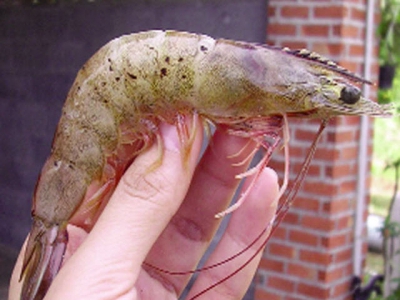Understanding shrimp hemocytes Part 2

3/ Concentration of dissolved oxygen and hemocyte production during a Vibrio spp. attack
The concentration of dissolved oxygen in water is one of the most important parameters in shrimp farming and is affected by environmental factors such as large plankton production and excessive accumulation of organic matter on pond bottoms. This increases the bacterial activity and leads to excessive oxygen consumption. Low levels of oxygen can affect the survival and growth of shrimp, because the reduced respiration and osmotic pressure of the shrimp at extremes can cause mortalities.
The production of hemocytes in marine shrimp depends on the concentration of oxygen in the water when pathogenic bacteria such as Vibrio spp. attack This is demonstrated by experiments carried out at different oxygen concentrations (7.5, 5.5, 3.5 and 2.0 ppm of dissolved oxygen in the water) (Fig. 5). The pathogenic bacteria Vibrio spp. could be controlled when the concentration of dissolved oxygen was at 5.4 and 7.5 mg/L, while the amount of hemocytes was relatively low at concentrations of 2.0 and 3.5 mg/L causing the shrimp to have very low defenses against these bacterial attacks (Ling-Xu Jiang et al., 2005).

Fig. 5: Effect of the concentration of dissolved oxygen (DO) in the production of hemocytes during an attack of Vibrio bacteria on L. vannamei (Ling-xu Jiang et al., 2005).
4/ Shrimp immune response at different pH levels
Studies conducted with L. vannamei shrimp exposed to a pathogenic strain of Vibrio alginolyticus (8.0 x 105CFU) at different pH levels showed differences in final survival (Li and Chen 2008). The lowest survivals were obtained at the lowest (6.5) and highest (10.1) pH, while the highest survival was obtained at pH 8.2. However, the pathogenic bacteria continued to reduce survival in all pH scenarios as the hours of exposure progressed (Fig. 6).

Fig. 6: Survival of L. vannamei in different pH conditions after infection with Vibrio alginolyticus. This survival was correlated to the immune response of the shrimp, with the most deficient ones occurring at pH 6.5 and 10.1 (Li and Chen, 2008).
This study of the effect of pH on shrimp survival (Li and Chen, 2008) showed that, in shrimp culture, the most important parameter to stop vibriosis is the concentration of dissolved oxygen. However, if sudden changes in pH are experienced, shrimp survival could be reduced by reducing defense mechanisms such as phagocytic activity (Fig. 6), even with high concentrations of dissolved oxygen.
5/ Sudden salinity changes decrease shrimp immune response
Experiments carried out with shrimp at 25 ppt salinity, injected with Vibrio alginolyticus (1.0 x 104CFU) and subsequently transferred to salinities of 5, 15, 25 (control) and 35 ppt for 24 to 96 hours, showed that the highest shrimp mortality occurred in those animals transferred from 25 to 5 ppt ‰ than for those shrimp transferred from 25 to 35 ppt. The shrimp were analyzed for total hemocyte count, phenol oxidase activity, respiratory burst, superoxide dismutase activity, phagocytic activity and bactericidal effect for V. alginolyticus.
Results indicate that when an abrupt change is made from a higher salinity (25 ppt) to a lower salinity (15 or 5 ppt), the immune defenses of the shrimp and their resistance to vibrios are diminished. Whereas if the shrimp in low salinity (25 ppt) are transferred to a high salinity (35 ppt), animal survival is not affected (Fig. 7). Therefore, an acclimation protocol is recommended that allows animals to have an appropriate time to osmoregulate with the water salinity without affecting their immune response (in the presence of vibrios), and, consequently, their survival.

Fig. 7: Phagocytic activity of L. vannamei maintained at a pH of 8.2 and then transferred to pH 6.5, 8.2 (control) or 10.1 by 6, 12, 24, 72 and 120 hours. The salinity was maintained at 34 ppt and the dissolved oxygen concentration above 5 ppm (Li and Chen, 2008).

Fig. 8: Total hemocyte count (A) and phenoloxidase activity (B) of L. vannamei maintained at a salinity of 25 ppt at the beginning and after 12, 24, 48 and 72 hours after transfer to 5, 15, 25 and 35 ppt salinity. Each bar represents the average value of eight determinations with standard error (different letters are significantly different values with p <0.05).
6/ Health diets complement the antibacterial action of hemocytes
In parallel to properly managing the aquatic environment during disease attacks for a greater production of hemocytes, it is advisable to complement these actions with the use of health diets such as Nicovita TERAP, whose antibacterial action is based on the use of organic acids that can inhibit and/or eliminate pathogenic bacteria in shrimp. In addition, the antibacterial action of these diets is also based on the action of its included immunostimulants, such as beta-glucans, nucleotides, selenium and zinc that increase the production of hemocytes in shrimp.
Thus, acting together through an improved aquatic environment and health diets as mentioned above, it is possible to achieve an effective control of pathogens such as bacteria Vibrio spp. which cause vibriosis, one of the most common and deadly diseases in cultured marine shrimp.
References available from author.
Related news
 Emerging disease: Shrimp Hemocyte Iridescent Virus (SHIV)
Emerging disease: Shrimp Hemocyte Iridescent Virus (SHIV) A newly discovered iridescent virus that causes severe disease and high mortality in farmed Pacific white shrimp (Litopenaeus vannamei) in Zhejiang, China
 Use algorithms to calculate feed for Pacific white shrimp
Use algorithms to calculate feed for Pacific white shrimp Shrimp aquaculture has a great impact on Ecuador’s national economy. As of July 2018, cumulative shrimp harvests had reached 289,431 metric tons (MT) and $1,868
 Understanding shrimp hemocytes Part 1
Understanding shrimp hemocytes Part 1 Shrimp producers seeking to improve the profitability of their crops must be aware of external factors that may affect the survival and growth of their shrimp